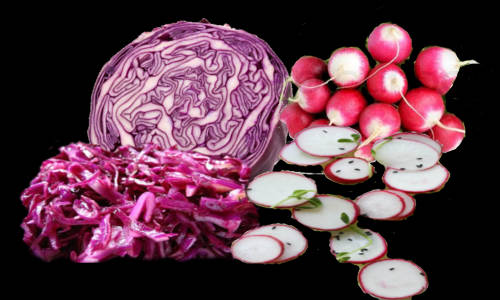NutriScience for everybody
Processing, preaparing and eating
Brassica sp vegetables

Plants contain a variation of compounds some of which can be thermally labile. Different cooking methods have different effects on the nutrients and phytochemicals compounds and also the same cooking method may have different effects on different types of plants. Vegetables from Brassica sp can benefit largely our health if they are processed, prepared and ate in the right way.
The particular interest for hydrolysis products from glicosinolates from Brassica sp is due to their anticarcinogenic properties and also to their contribution to the characteristic flavor and odor of many Brassicaceae[2]. All members of the genus Brassica which belong to the Cruciferous family are reported to posses both antioxidant and health-promoting properties[3]. Brassica vegetables are rich in sulfur-containing glucosides called glucosinolates that needs to be hydrolyzed for getting the breakdown products that have the bioactive anticarcinogenic properties.
The glucosinolates are hydrolyzed into bioactive breakdown products such as isothiocynates, nitriles, and thiocynates by the endogenous enzyme myrosinase. The activity of myrosinase is known to increase with moderate heat at temperatures up to 60°C, although it is inactivated at 100°C[2]. The majority of domestic cooking causes myrosinase denaturation or inactivation, while glucosinolates remain intact[1], so when Brassica sp vegetables are cooked, glucosinolates can’t breakdown in their bioactive compounds. Also blanching cruciferous vegetables prior to freezing may denature myrosinase[1].
When eating fresh Brassica vegetables, the plant tissue is damaged by mastication and/or by processing of the vegetables, the glucosinolates are hydrolyzed in the mouth into bioactive breakdown products such as isothiocynates, nitriles, and thiocynates by the endogenous enzyme myrosinase[2].
Although myrosinase is largely inactivated during the thermal treatment of vegetables, isothiocyanate metabolites were nevertheless excreted, and cardioprotective effects of glucosinolates as well following as thioglucosidase the induction of phase II by were observed following the intake of cooked Brassica vegetables. Mammalian thioglucosidase activity has so far not convincingly been demonstrated. Therefore, gut bacteria were assumed to play a role in the activation of glucosinolates in the intestinal tract after the ingestion of cooked Brassica sp vegetables[4].
Brassica sp have many other phytochemicals in add to glusinolates, such as phenolic and flavonoid compounds and vitamin C. When Brassicaceae is cooked, it has been reported that boiling losses of 97%, 74%, and 87% in flavonoids, sinapic acid derivatives, and caffeoylquinic acid derivatives, respectively, also losses were reduced to 20%–30% by steaming cooking, revealing that this is the optimal method to safeguard secondary metabolites in Brassica crops[1]. Results of study on total phenolics showed that cooking had a negative effect on phenolics content after 5 and 10 min compared with the raw vegetable. Steaming was the only method that retained the total phenolics content in the vegetables cooked, with an enhancement found in cauliflower[3]. When microwave cooking and boiling cause losses of antioxidants and phenolics in the vegetables, and that the phenolics are largely leached into the cooking water[3].
In another hand, storage at a low temperature has an effect on the antioxidant activity. It was reported that refrigeration at 4°C was the best preservation method for maintaining a high content of glucosinolates in broccoli, showing after 5 days a 16% and 4% decrease for the principal and secondary inflorescence, respectively. Conversely, it was reported an average sulforaphane decrease of 39% in broccoli stored in perforated polyethylene bags at 4°C for 7 days, reaching a 55% decrease after 21 days of storage[2].
_______[1] Raiola, Assunta et al. 2018. Bioactive Compounds in Brassicaceae Vegetables with a Role in the Prevention of Chronic Diseases. Molecules, 23, 15.
[2] Galgano, E. et al. 2007. The Influence of Processing and Preservation on the Retention of Health-Promoting Compounds in Broccoli. Of Food 72, Nr. 2.
[3] Wachtel-Galor, Sissi et al. 2008. The effect of cooking on Brassica vegetables. Food Chemitry 110, 706–710
[4] Budnowski, Julia et al. 2015. Glucosinolates Are Mainly Absorbed Intact in Germfree and Human Microbiota-Associated Mice. J. Agric. Food Chem., 63, 8418−8428.
Brassica sp vegetables
The best processing techniques
When it is possible eat them raw.
If you want to eat them cooked:
Get fresh vegetables and avoid storage.
Always eat them in normal portion sizes
eidos-project.net © 2016- 2025